This is a recent Swisher podcast and is relevant to the discussion of power of big tech. Fei Fei Li is a prominent AI researcher. One of the more interesting issues from this discussion was Li’s effort to describe how the big companies had a position of control over AI relative to the role often played by higher education. The investment required to explore AI seems far too great for even the most well-funded institutions to take on. This situation has eliminated the more careful and nuanced role higher education can play in evaluating ethical and human issues. The focus in big tech corporations quickly focuses on profit opportunities. Li proposed that government assist multiple institutions in developing a consortium to pursue a wider range of research and evaluative topics.
Big tech squeezing out universities
Is something wrong with higher education?
I am concerned that political pressures and market forces are narrowing the goals of colleges and universities, steering these institutions towards an approach focused predominantly on job preparation. However, is this focus on career readiness truly the sole purpose of higher education, or is there more that we should demand from our academic journeys?
Colleges and universities have traditionally been bastions of learning, not just in the professional sense, but in a way that prepares us for the diverse challenges of life. This includes fostering critical thinking, nurturing an understanding of societal inequities, and equipping us to be responsible citizens in an ever-evolving global society.
This post delves into this complex and multifaceted issue, exploring the essential roles that colleges and universities should play in shaping not just our careers, but our characters, our communities, and our perspectives on the world. We must ask ourselves: are we expecting an education that truly prepares us for the many challenges of life, or are we being funneled into a narrow focus on occupational readiness, at the expense of a richer, more comprehensive educational experience?
The perceptions surrounding the priorities of higher education are influenced by a confluence of factors, each contributing to the growing skepticism about the role and value of colleges and universities. A major concern fueling this debate is the issue of high college debt. As tuition fees soar, students and their families are increasingly questioning the return on investment of a college education. The burden of this debt often lingers for years post-graduation, leading many to wonder if the education provided is worth the financial strain. Coupled with this is the rising cost of textbooks and other educational resources, adding to the financial pressures faced by students. These economic factors inevitably color public perception, turning the spotlight onto the immediate employability and earning potential of graduates rather than the broader educational objectives.
Additionally, there’s a growing sentiment that graduates are not adequately prepared for the job market. Employers often cite a skills gap, pointing to a mismatch between what students learn in college and the practical skills required in the workplace. This perception challenges the effectiveness of higher education in fulfilling its most basic objective: preparing students for employment. Compounding these concerns are claims of political bias within educational institutions. Critics argue that educators often impart a particular political ideology, influencing students’ perspectives and potentially detracting from a more balanced and objective educational experience. This criticism often leads to questions about the neutrality and overall purpose of higher education.
Moreover, the relevance of certain areas of study is increasingly under scrutiny. Critics argue that many academic disciplines, especially within the liberal arts and humanities, do not directly prepare students for specific job roles, leading to questions about their practical value in an employment-centric society. This viewpoint underscores a fundamental shift in expectations, where the measure of an education’s worth is increasingly seen through the lens of immediate job readiness and less through the development of a well-rounded, critically thinking individual. These complex factors together fuel the debate over the priorities of higher education, questioning whether its goals should be broad and holistic or narrow and occupation-focused.
The legitimacy of claims regarding the priorities and challenges of higher education is a multifaceted issue, requiring a nuanced understanding of the economic, social, and ideological dimensions at play.
Firstly, the question of whether college costs are unreasonably high is not straightforward. On one hand, the rising cost of higher education is undeniable, with tuition fees increasing significantly over the past few decades. However, this increase is not solely due to the institutions’ drive for profit. Higher education has evolved to encompass far more than classroom and laboratory experiences. Today’s students often have high expectations for their college experience, which extend to campus amenities like advanced living and dining options, state-of-the-art health clubs, and vibrant entertainment and athletic programs. These amenities, while enhancing the student experience, come with substantial costs. Universities find themselves in a competitive market where such facilities can be crucial in attracting students and their tuition dollars. This necessitates a delicate balance for administrators between providing an enriching campus life and managing the escalating costs associated with these extras.
Regarding the support for public institutions, the role of state funding is critical. Public universities rely heavily on state appropriations, but in recent years, many states have reduced their financial support for higher education. This reduction has shifted a greater portion of the cost to students and their families, contributing to the rise in student debt. The irony here is that the politicians who often criticize the high cost of college and the resulting student debt are also in control of state budgets that could alleviate some of these financial burdens. This creates a complex dynamic where the very bodies questioning the cost of higher education are also responsible for funding decisions that impact these costs.
The issue of liberal bias in higher education is another intricate matter. It’s true that certain fields of study, such as education, social work, and psychology, might naturally align more with liberal perspectives due to the nature of their subject matter, which often focuses on social improvement and human welfare. Furthermore, those who choose careers in academia might be more inclined towards liberal values, influencing the ideological leaning of these fields. However, this does not necessarily equate to a systemic bias across all of higher education. Universities traditionally encourage diverse viewpoints and critical thinking, and many institutions make concerted efforts to ensure a broad range of perspectives is represented in their curricula and faculty. Nevertheless, the perception of liberal bias persists, partly due to the broader societal and political polarization, and it remains a contentious issue in discussions about the role and nature of higher education.
In conclusion, the claims about the priorities and challenges of higher education are complex and cannot be easily categorized as entirely legitimate or unfounded. They are influenced by a range of factors, including economic pressures, societal expectations, competitive market dynamics, state funding policies, and ideological leanings. These factors interplay in intricate ways, shaping the landscape of higher education and the ongoing debates about its purpose and value in modern society.
In summary, the legitimacy of the claims about the priorities and challenges of higher education cannot be easily resolved. They are influenced by economic factors, societal expectations, state funding policies, and ideological leanings. These elements intertwine, shaping the evolving landscape of higher education and the ongoing debate about its purpose in contemporary society. Unlike other posts I write, much of what appears here is a matter of impressions and personal values that you may or may not hold. Part of my reaction is based on an impression that we are in a time when education at all levels is held responsible for much that has not historically been the case and institutions become an easy target for politicians who know that state and federal sources fund most educational institutions.
K12 Curricular Wars
Larry Cuban, a writer frequently addressing historical issues in education, recently addressed the multiple recurring controversies in education and wondered without resolution why these battles (e.g., the recent National political interest in how reading is taught in the elementary grades) continue generation after generation.
His post focuses on two main questions:
What content and skills should be taught to U.S. children and youth?
How should both be taught?
Cuban makes an interesting observation that matches my experience.
“ …few teachers get involved in these “wars” or teach lessons clearly on one side or the other of the issue once they close their classroom doors.”
Cuban notes that in the early 1950s, policy elites including federal and state officials began to “educationalize” national social, economic, and political problems. This meant they expected schools to solve these problems, giving them more control over curricular policy. These expectations are examined and reexamined on cable television political channels. Criticism is what educators hear and the result has been many educators leaving the field and fewer college students looking at education as a career.
Cuban’s observations reminded me of a claim I heard about the attitude people have about K-12 education. Parents are quick to complain about education, but much less so about the schools their kids attend and their students’ teachers. There seems a vague need to complain but the experiences of parents make it difficult for them to have a specific target. Some complain about the books in the library, but that seems the extent of the specific changes they can vocalize.
Note: I have resorted to using AI to generate supporting images for some of my posts.
Apple News+
I have discovered the solution to a problem that has baffled me and others probably found to be no challenge. I often encounter references to news articles that appear to interest me, but when I try to read the articles I find they are behind a paywall. I understand the issue of online content needing to support content creators and services so I have no real issue with this situation beyond wishing there was a reasonable micropayment system that could be applied. Anyway, I subscribe to the NYTimes and the local online paper, but find myself interested in articles appearing in the Wall Street Journal, New Yorker, Atlantic and many other news outlets.
We purchased an Apple News+ subscription as a way to expand to many (Washington Post not included) of the outlets that interest me. The problem I encounter is finding articles I want in any but the most current issue. Often, what I have is a title and not the citation providing publication date and page number.
The obvious solution is a search feature which I make use of on my desktop machine, but I was baffled by where the search box was when trying to track down an article from my phone. I finally figured out the issue and will demonstrate both the problem and solution here for anyone interested.
The following is the display I see when connecting to Apple News+. No icon that says search. The solution is to select Following. I fear I have become very literal in my old age because I needed to see a search icon or a search box.
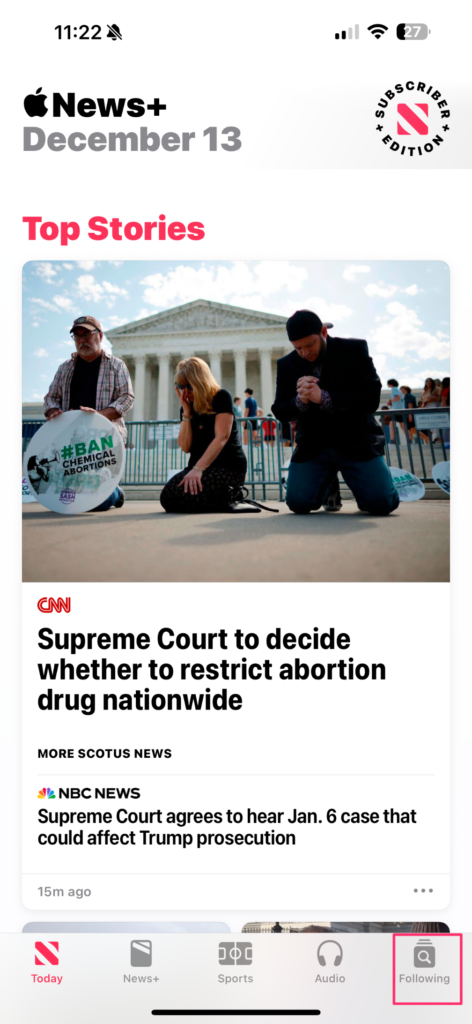
If you select Following, you are taken to a display that contains the sources you frequently consult and at the top of the page a search box.
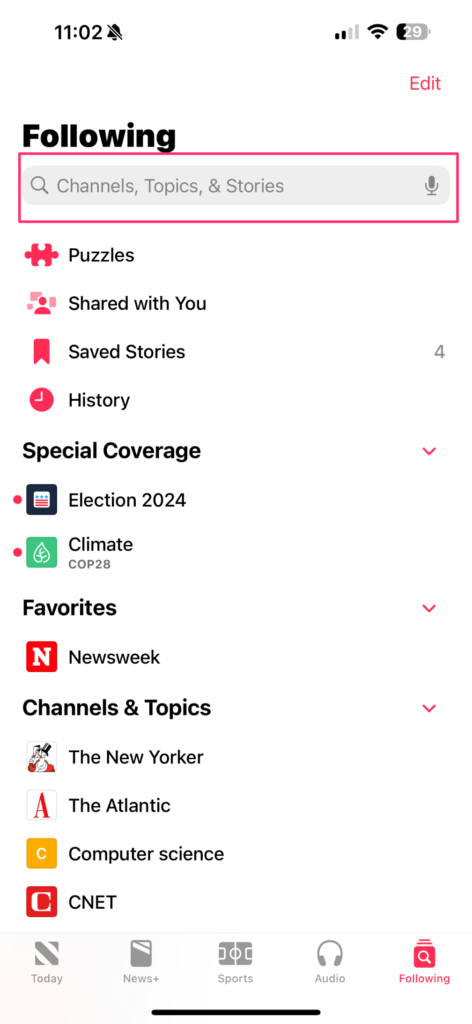
Perhaps this was obvious to everyone else, but I was confused for some time. Whether this information is helpful or not, I do recommend Apple News+ as a solution to the “I can’t subscribe to every news source I might use once a month” problem.
OpenAI Mess
The conflict between OpenAI’s Board of Directors and Sam Altman was a complex and controversial event. Altman was initially fired by the Board, but then reinstated after several Board members resigned. A New Yorker article provides a detailed account of the situation, including the role of the OpenAI Charter and the different perspectives of Altman and the Board. Educators may be interested in this controversy because OpenAI is responsible for ChatGPT and this service has received a good deal of classroom attention. For some, the OpenAI controversy led to concerns regarding whether ChatGPT was an appropriate tool.
The Charter of OpenAI states that the organization’s mission is to ensure that artificial general intelligence benefits all of humanity and is to be developed in a careful and safe manner. The Board felt that Altman was not adhering to this mission and that he was prioritizing the development of AI over safety concerns. Altman, on the other hand, argued that the Board was being too cautious and that the only way to make progress in AI was to move quickly.
Fast progress required funding which Altman and developers thought could be provided by sale of focused ChatGPT applications and copilot development in collaboration with Microsoft. OpenAI also developed a relationship with Microsoft. Microsoft initially invested one billion and now a total of 13 billion.
Microsoft was interested in the collaboration to support the development of copilot and differences in how AI progress should be achieved would not exactly meet the expectations of careful and safe. Microsoft’s way of thinking about copilot and AI capabilities provided the public reasoned that what was made available would not have to be perfect and users would understand this was the case. Users would understand AI recommendations should be treated as suggestions that require evaluation and these same users would report when recommendations were flawed. Deployment “in the wild” under such circumstances was the best way to discover problems the developers could then fix.
The lack of trust that was initially given as an explanation for Altman’s termination was reported in the article to be related to a conflict between Altman and Board member Helen Toner. Toner had written a paper critical of OpenAI. In comparing notes, Board members discovered that Altman had been making claims that members had suggested getting rid of Toner and this was evidently not the case (more on the Toner conflict).
The New Yorker article provides a valuable perspective on the OpenAI conflict. It sheds light on the different factors that contributed to the conflict, and it offers insights into the different ways in which AI can be developed and used.
The article also raises important questions about the future of AI. How can we ensure that AI is developed in a way that benefits all of humanity? How can we balance the need for safety with the need for progress? These are complex questions, but they are essential to the future of AI.
The New Yorker article is a valuable resource for anyone who is interested in the future of AI. It provides a balanced and comprehensive account of the OpenAI conflict, and it raises important questions about the development and use of AI.
AI Images in Padlet
I have not written a Padlet tutorial in quite a while and I recently learned of a new feature that may interest educators and students. I have followed the development of Padlet since it was first released and I have described it as an embellished document within the system of multimedia products we describe in our textbook (a few related related posts – 2018, 2022).
The new feature of Padlet allows the use of AI to create images to be added to a Padlet. I will quickly take you through the process. I have an existing Padlet focused on Kona Coffee. The tutorial that follows is based on the use of a computer. I find this a little easier than using a tablet.
To add any object to a Padlet, you double click at some location within the the Padlet. This will bring up a menu
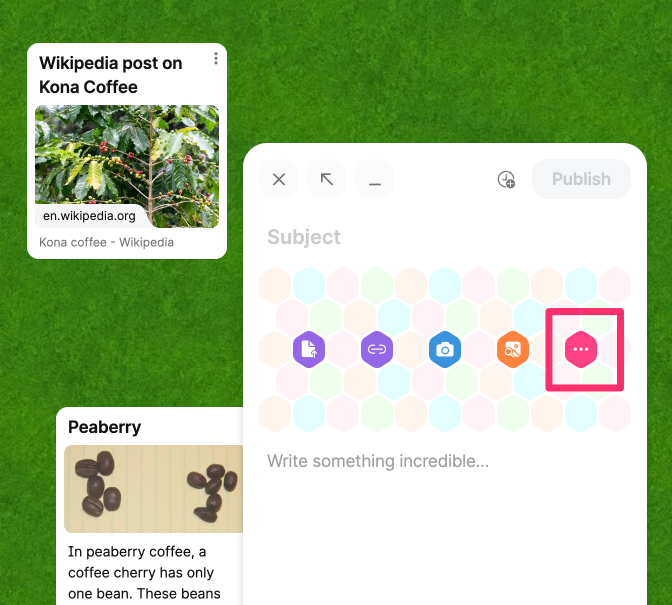
Select the three-dot icon for more choices.
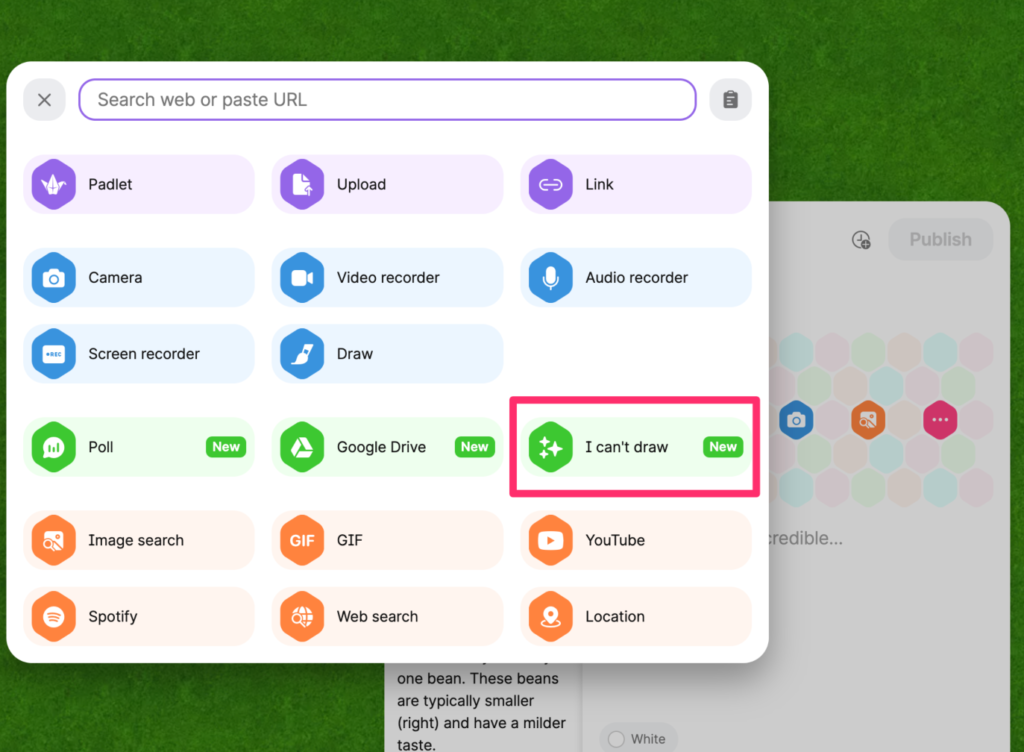
The option you are looking for is “I can’t draw”.
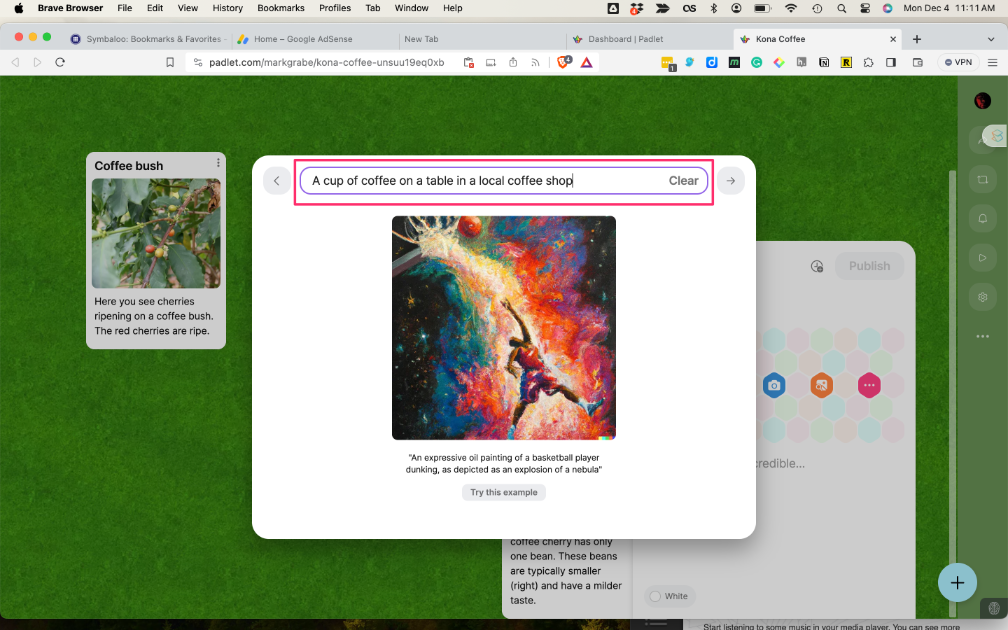
This will open up access to the AI tool and you enter a description of the image you want. I asked the tool to create an image showing “A cup of coffee on a table in a local coffee shop.” Simple as that.

The AI tool generated 6 great options and I clicked on one to use.
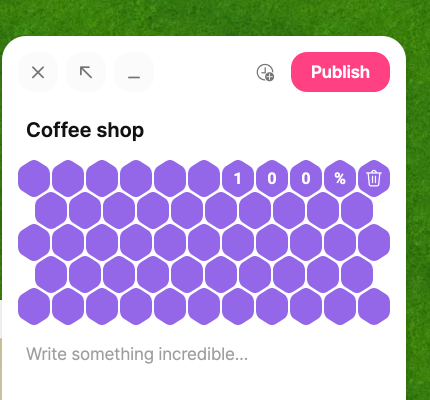
It takes a bit and you will see this view while you wait. Eventually, the counter will reach 100% and you then publish. The selected image will appear within your Padlet.

I make the greatest use of AI for other things, but the image generation capabilities are very impressive.
Wikipedia needs support

Several of the social media outlets I follow are asking for money claiming that ad revenue is drying up. Wikipedia does not take advantage of ad revenue, but is also asking for donations to continue their present approach. I link to Wikipedia often enough within my posts I decided it was appropriate I donate. I would argue many others should consider their own online activity and come to the same conclusion.
Medium vs Substack
I have content on both Medium and Substack. As a writer, I do not regard either platform with the seriousness required to develop a significant following or assume I should expect compensation for my contributions. I have been a blogger since 2002 and do not see abandoning this body of work and focusing on either Substack and Medium. However, experience with both platforms has given me insights into differences in the experiences of readers and these are my focus in this post.
The cost to readers depends on what a reader wants. If you are looking for unlimited free content, you can find lots of free posts on Substack. Medium limits free access to three articles per month. A subscription to Medium costs $50 per year, but then provides unlimited access to the content generated by all authors. Authors wanting to earn money from their work on Substack typically offer some content for free, but also put content behind a subscription paywall. The balance between free and paid is up to the author. Subscriptions to the work of individual authors vary in annual cost, but $50 is probably a reasonable estimate for purposes of platform comparisons.
I think the choice comes down to how much value you place in the work of an individual author. I think about a $50 subscription in comparison to how many Kindle books I could buy for this investment. I purchase probably one Kindle book a month and I also have an audiobook annual subscription that also requires the purchase of one book a month. I find the lengthy consideration of an issue provided by a single author integrated as a book preferable to following say the work of a blogger who likely mixes multiple topics over an extended period of time. I can purchase three Kindle books for each Substack author I might follow. For the same expenditure, I can read as many of the Medium posts from any writer I want to follow.
I have no idea what the monetary advantages to an author would be on Medium versus Substack. I am certain individuals who seek revenue from their posts have examined this issue carefully. My guess would be that “popular” writers would prefer Substack and those wanting to make some money but who lack a large following would prefer Medium.
A more interesting question is what do readers prefer. There is plenty to read on Substack without a subscription to a Substack author, but for the cost of one Substack subscription I can read the work of all Medium contributors. Part of the issue here is what is the quality or value of what is available on Medium and how does a reader reach a decision about the value of complete access when a prospective reader is allowed to review a very limited number of offerings each month.
I have a couple of subscriptions on Substack and I have a Medium subscription. I like the idea of micropayments which is what Medium appears to support. Writers receive more revenue when more readers access and read their work. In comparison to an ad-based model, I like the micropayment approach.
I always run into a problem of the consideration of multiple characteristics when I am making a decision regarding online services. Often, each option has some specific things I like and some I do not. This is a good example of such a conundrum. Maybe I should turn the issue around a make statement to authors. I like some of your content, but not well enough to add you to those I subscribe to on Substack. For me, you would get some of my “reading money” if you put your content on Medium.
I should add one caveat. I think I understand the pricing options offered by these two platforms. As a writer, I don’t have enough experience to know for certain. I welcome corrections if I have something wrong.
Is AI progress now beyond our control
I recently read what I found to be a depressing account of the future of AI by Deepmind founder Mustafa Suleyman (The Coming Wave). The author examines developments in synthetic biology and artificial intelligence concluding that despite the obvious advantages of both fields (and the interaction of these two technologies) both areas are advancing in capabilities and applications so rapidly that serious dangers are very difficult to address.
When I say depressing, I mean that ways to address the negative potential of these fields seem unavoidable. His explanation of the dangers made a solid case. Both fields have escaped the typically slow pace of academic research labs and are being developed by commercial entities. The money required for the infrastructure and personnel requirements are beyond the reach of even the most elite universities. These organizations are in a breakneck race to control the market with huge revenue opportunities in the balance. Whether or not our government will step in to establish regulations and monitoring to require careful consideration of dangers, the governments in other countries will not have the same motives and see these fields as key to international power.
While bigger is one of the characteristics creating this challenge, smaller also contributes. While large corporations or even nations create the tools of AI and synthetic biology, the use of these tools once available is in control of individuals. Many will have the capabilities to implement uses of AI and synthetic biology.
The recent OpenAI upheaval seems an example of some of these issues in action. OpenAI originated in part to provide an alternative to the efforts of big corporations. Even as a well-funded nonprofit, OpenAI sought additional funding opportunities in part leading to disagreements between the board and key personnel. It seemed AI innovation would continue no matter any position taken by OpenAI and just to remain a credible option to the efforts of huge established companies, OpenAI must sell products and make its products more adaptable to the interests of individual users.
Let me in
It has been a crazy week for OpenAI and ChatGPT. Sam Altman announces customizable GPTs and then he gets let go by his board. I have no idea if these events are related and information is scarce. It appears that Altman may be negotiating with the board so it is difficult to know what to expect.
I am very interested in the new GPT opportunities. I have found applying an AI client to investigate content I specify to be one of the most immediate opportunities and this appears to be the benefit of some of the customizations. You do need to pay for the $20 a month plan to apply any of these options. When I tried I found that the system is overloaded and interested users are now on a waiting list.


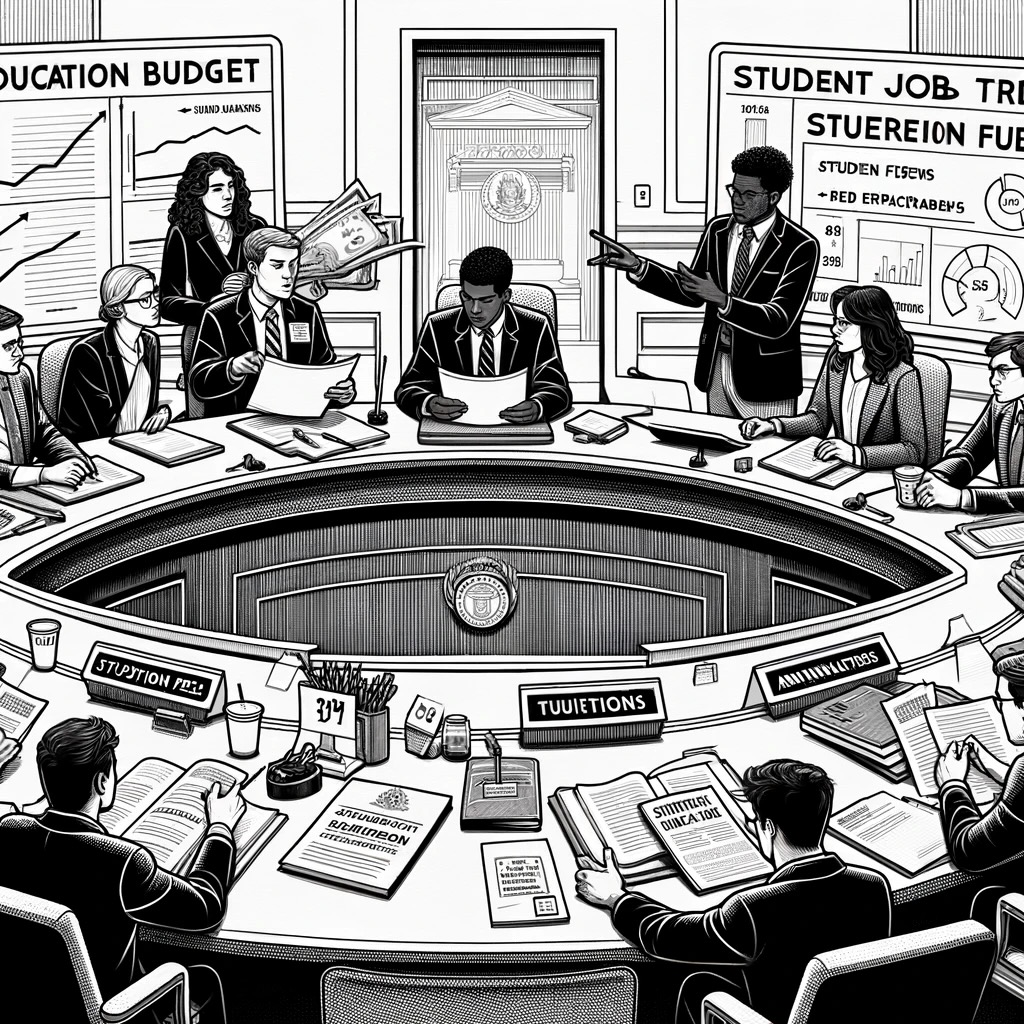
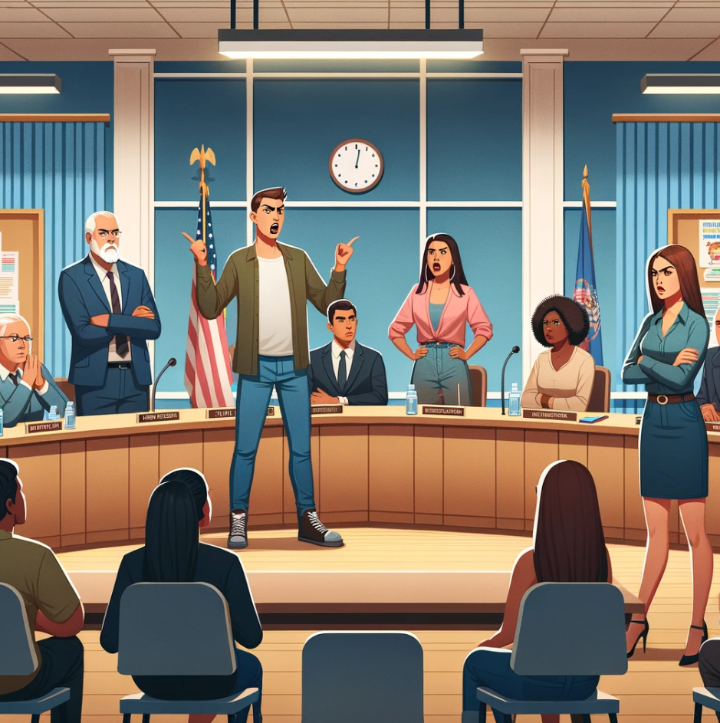
You must be logged in to post a comment.